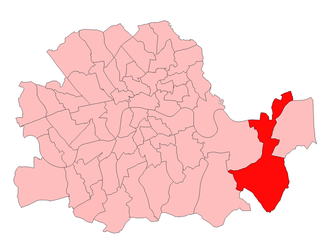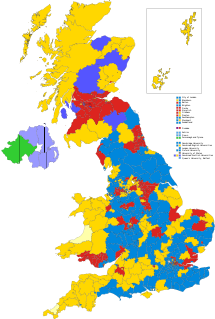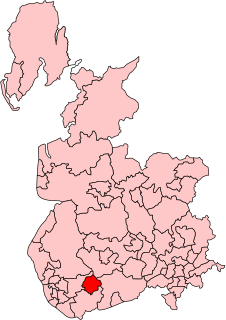Boundaries

The Urban District of Leyton wards of Cann Hall, Grove Green, Harrow Green, Leytonstone, and Wanstead Slip.
| Leyton East | |
|---|---|
| Former Borough constituency for the House of Commons | |
| 1918–1950 | |
| Number of members | one |
| Replaced by | Leyton |
| Created from | Walthamstow |
Leyton East was a parliamentary constituency in the Municipal Borough of Leyton, then part of Essex but now in Greater London.
It returned one Member of Parliament (MP) to the House of Commons of the Parliament of the United Kingdom, elected by the first past the post system.

The Urban District of Leyton wards of Cann Hall, Grove Green, Harrow Green, Leytonstone, and Wanstead Slip.
The constituency was created for the 1918 general election, and abolished for the 1950 general election.
| Election | Member | Party | |
|---|---|---|---|
| 1918 | Cecil Malone | Liberal | |
| 1919 | British Socialist | ||
| 1920 | Communist | ||
| 1922 | Ernest Edward Alexander | Unionist | |
| 1923 | Archibald Church | Labour | |
| 1924 | Ernest Edward Alexander | Unionist | |
| 1929 | Fenner Brockway | Labour | |
| 1931 | Sir Frederick Mills | Conservative | |
| 1945 | Albert Bechervaise | Labour | |
| 1950 | constituency abolished: see Leyton | ||
| Party | Candidate | Votes | % | ±% | |
|---|---|---|---|---|---|
| C | Liberal | Cecil Malone | 4,319 | 35.7 | |
| Unionist | Ernest Edward Alexander | 4,119 | 34.0 | ||
| Labour | William Carter | 3,668 | 30.3 | ||
| Majority | 200 | 1.7 | |||
| Turnout | 12,106 | 45.3 | |||
| Liberal win (new seat) | |||||
| Cindicates candidate endorsed by the coalition government. | |||||
| Party | Candidate | Votes | % | ±% | |
|---|---|---|---|---|---|
| Unionist | Ernest Edward Alexander | 7,866 | 38.6 | +4.6 | |
| Labour | William Carter | 6,300 | 30.9 | +0.6 | |
| National Liberal | Walter Gibbons | 4,568 | 22.4 | New | |
| Liberal | Edward Brotherton-Ratcliffe | 1,650 | 8.1 | −27.6 | |
| Majority | 1,566 | 7.7 | N/A | ||
| Turnout | 20,384 | 72.2 | +26.9 | ||
| Registered electors | 28,232 | ||||
| Unionist gain from Liberal | Swing | +16.1 | |||
| Party | Candidate | Votes | % | ±% | |
|---|---|---|---|---|---|
| Labour | Archibald Church | 7,944 | 39.5 | +8.6 | |
| Unionist | Ernest Edward Alexander | 6,533 | 32.4 | −6.2 | |
| Liberal | Thomas Broad | 5,669 | 28.1 | +20.0 | |
| Majority | 1,411 | 7.1 | N/A | ||
| Turnout | 20,146 | 69.1 | −3.1 | ||
| Registered electors | 29,166 | ||||
| Labour gain from Unionist | Swing | +7.4 | |||
| Party | Candidate | Votes | % | ±% | |
|---|---|---|---|---|---|
| Unionist | Ernest Edward Alexander | 10,649 | 46.4 | +14.0 | |
| Labour | Archibald Church | 9,087 | 39.7 | +0.2 | |
| Liberal | R.W. Puddicombe | 3,174 | 13.9 | −14.2 | |
| Majority | 1,562 | 6.7 | N/A | ||
| Turnout | 22,190 | 77.6 | +8.5 | ||
| Registered electors | 29,506 | ||||
| Unionist gain from Labour | Swing | +6.9 | |||
| Party | Candidate | Votes | % | ±% | |
|---|---|---|---|---|---|
| Labour | Fenner Brockway | 11,111 | 42.9 | +3.2 | |
| Unionist | Ernest Edward Alexander | 8,691 | 33.6 | −12.8 | |
| Liberal | Frank Wynne Davies | 6,096 | 23.5 | +9.6 | |
| Majority | 2,420 | 9.3 | N/A | ||
| Turnout | 25,898 | 72.6 | −5.0 | ||
| Registered electors | 35,680 | ||||
| Labour gain from Unionist | Swing | +8.0 | |||
| Party | Candidate | Votes | % | ±% | |
|---|---|---|---|---|---|
| Conservative | Frederick Mills | 17,285 | 62.4 | +28.8 | |
| Ind. Labour Party | Fenner Brockway | 10,433 | 37.6 | New | |
| Majority | 6,852 | 24.8 | N/A | ||
| Turnout | 27,718 | 75.7 | +3.1 | ||
| Conservative gain from Labour | Swing | ||||
| Party | Candidate | Votes | % | ±% | |
|---|---|---|---|---|---|
| Conservative | Frederick Mills | 10,836 | 46.1 | -16.3 | |
| Labour | Albert Bechervaise | 10,507 | 44.7 | New | |
| Liberal | Edwin Malindine | 2,161 | 9.2 | New | |
| Majority | 329 | 1.4 | -23.4 | ||
| Turnout | 23,504 | 67.1 | -8.6 | ||
| Conservative hold | Swing | ||||
| Party | Candidate | Votes | % | ±% | |
|---|---|---|---|---|---|
| Labour | Albert Bechervaise | 13,048 | 65.7 | +21.0 | |
| Conservative | Bernard Braine | 6,802 | 34.3 | -11.8 | |
| Majority | 6,246 | 31.4 | N/A | ||
| Turnout | 19,850 | 68.2 | +1.1 | ||
| Labour gain from Conservative | Swing | ||||
New Forest and Christchurch was a county constituency in Hampshire which elected one Member of Parliament (MP) to the House of Commons of the Parliament of the United Kingdom. It was created for the 1918 general election, partially replacing the previous New Forest constituency, and was abolished for the 1950 general election, when it was partially replaced by a recreated New Forest constituency.
Birmingham Aston was a constituency of the House of Commons of the Parliament of the United Kingdom. From 1918 to 1974 it elected one Member of Parliament (MP) by the first-past-the-post system of election.

Woolwich West was a borough constituency represented in the House of Commons of the Parliament of the United Kingdom from 1918 until 1983. It centred on Eltham, now in the Royal Borough of Greenwich in south-east London.

Camborne was a county constituency in Cornwall which returned one Member of Parliament to the House of Commons of the Parliament of the United Kingdom. It was created for the 1885 general election, and abolished for the 1950 general election, when it was largely replaced by the new Falmouth and Camborne.

Balham and Tooting was a constituency in South London, which returned one Member of Parliament (MP) to the House of Commons of the Parliament of the United Kingdom. It was created for the 1918 general election and abolished for the 1950 general election.
Birkenhead East was a parliamentary constituency centred on the Birkenhead area of Merseyside. It returned one Member of Parliament (MP) to the House of Commons of the Parliament of the United Kingdom, elected by the first past the post voting system.
Tonbridge was a parliamentary constituency in Kent, centred on the town of Tonbridge. It returned one Member of Parliament (MP) to the House of Commons of the Parliament of the United Kingdom.
Walthamstow West was a borough constituency in what is now the London Borough of Waltham Forest, but was until 1965 the Walthamstow Urban District of Essex. It returned one Member of Parliament (MP) to the House of Commons of the Parliament of the United Kingdom.

Consett was a county constituency, centred on the town of Consett in County Durham. It returned one Member of Parliament (MP) to the House of Commons of the Parliament of the United Kingdom, elected by the first past the post voting system.

Mitcham was a constituency comprising the emerging Mitcham, Wallington and Beddington suburbs of South London and until 1945 that of Carshalton, its largest of the area's four traditional divisions, in its south-west. It returned one Member of Parliament (MP) to the House of Commons of the Parliament of the United Kingdom by the first past the post system.
Llandaff and Barry was a county constituency centred on the towns of Llandaff and Barry in Wales. It returned one Member of Parliament to the House of Commons of the Parliament of the United Kingdom.
Leeds South East was a borough constituency in the city of Leeds in West Yorkshire. It returned one Member of Parliament (MP) to the House of Commons of the Parliament of the United Kingdom.

SouthwarkSouth East was a parliamentary constituency in the Metropolitan Borough of Southwark, in South London. It returned one Member of Parliament (MP) to the House of Commons of the Parliament of the United Kingdom.
Tottenham North was a parliamentary constituency centred on the Municipal Borough of Tottenham, in North London. It returned one Member of Parliament (MP) to the House of Commons of the Parliament of the United Kingdom.
Tottenham South was a parliamentary constituency in Tottenham, in North London. It returned one Member of Parliament (MP) to the House of Commons of the Parliament of the United Kingdom.
Rutland and Stamford was a county constituency comprising the area centred on the town of Stamford in Lincolnshire, and the county of Rutland. It returned one Member of Parliament (MP) to the House of Commons of the Parliament of the United Kingdom, using the first-past-the-post voting system.
Leyton West was a parliamentary constituency in the Municipal Borough of Leyton – then part of Essex but now in Greater London. It returned one Member of Parliament (MP) to the House of Commons of the Parliament of the United Kingdom, elected by the first past the post system.

St Helens was a constituency in the county of Lancashire, England. It returned one Member of Parliament (MP) to the House of Commons of the UK Parliament.

Enfield was a constituency for the House of Commons of the UK Parliament from 1885 until 1950. The area sloping to the River Lea in the east was in the far north of Middlesex centred on the town of Enfield. The area formed part of the London conurbation and was much reduced over the course of its existence, in 1918 and then insignificantly in 1945 due to suburbanisation and urbanisation. It returned one Member of Parliament (MP).

East Ham South was a parliamentary constituency centred on the East Ham district of London, which was in Essex until 1965. It returned one Member of Parliament (MP) to the House of Commons of the Parliament of the United Kingdom, elected by the first past the post voting system.